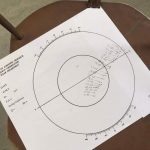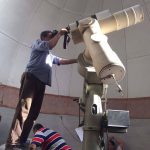Mercury is the closest planet to the Sun and due to its proximity it isn’t easily seen except during twilight. For every two orbits of the Sun, Mercury completes three rotations about its axis and up until 1965 it was thought that the same side of Mercury constantly faced the Sun.
Thirteen times a century Mercury can be observed from the Earth passing across the face of the Sun in an event called a transit.
Mercury doesn’t have any moons or rings. And because of its weak gravity; your weight on Mercury would be 38% of your weight on Earth.
A day on the surface of Mercury lasts 176 Earth days, and a year on Mercury takes 88 Earth days! Mercury has a diameter of 4,879 km, making it the smallest planet in the Solar System.
Despite of all the previous scientific facts, Mercury is the second densest planet. Each cubic centimeter has a density of 5.4 grams, with only the Earth having a higher density. This is largely due to Mercury being composed mainly of heavy metals and rock.
Mercury’s transit between Earth and our star lasted from 11:12 until 6:42 UTC. It was the 3rd such pass of 14 this century; the little planet won’t transit again until 2019 and then 2032.
AboutIslam.net joined sky watchers across the globe in enjoying the rare opportunity to see Mercury transit the Sun on Monday May 9, 2016.
The observation was conducted using filtered telescopes and projections of the Sun’s image on clear measurement sheets.
The Noble Qur’an is full of reflections on these observed Heavens. In the preceding chapter on the Creation, we saw how the plurality of the Heavens and Earths was referred to, as well as what the Qur’an calls an intermediary creation ‘between the Heavens and the Earth’, modern science has verified the latter.
The verses referring to the Creation already contain a broad idea of what is to be found in the heavens, i.e. of everything outside the earth.
Apart from the verses that specifically describe the Creation, there are roughly another forty verses in the Qur’an which provide information on astronomy complementing what has already been given.
Some of them aren’t much more than reflections on the glory of the Creator, the Organizer of all the stellar and planetary systems.
These we know to be arranged according to balancing positions whose stability Newton explained in his law of the mutual attraction of bodies.
In modern astronomy it’s known that the planets don’t have their own source of light like stars. The Holy Qur’an would seem to designate these by the word kaukab (plural kawakib) without stating their number. Prophet Joseph’s dream (sum 12) refers to eleven of them, but the description is, by definition, an imaginary one.
A good definition of the meaning of the word kaukab in the Qur’an Seems to have been given in a very famous verse. The eminently spiritual nature of its deeper meaning stands forth, and is moreover the subject of much debate among experts in exegesis. It is nevertheless of great interest to offer an account of the comparison it contains on the subject of the word that would seem to designate a ‘planet’.
Here is the text in question in Surat An-Nur 24: 35 where Allah Almighty says: “God is the light of the heavens and the earth. The similitude of His light is as if there were a niche and within it a luminary. The luminary is in a glass. The glass is as if it were a planet glittering like a pearl.”
Here the subject is the projection of light onto a body that reflects it (glass) and gives it the glitter of a pearl, like a planet that is lit by the sun. This is the only explanatory detail referring to this word to be found in the Qur’an.
The word is quoted in other verses. In some of them it is difficult to distinguish which heavenly bodies are meant (Surat Al-An’am 6:76 and Surat Al-Infitar 82:1-2.
In one verse however, when seen in the light of modern science, it would seem very much that these can only be the heavenly bodies that we know to be planets. In Surat As-Saffat 37:6, we see the following: “We have indeed adorned the lowest heaven with an ornament, the planets.”
















